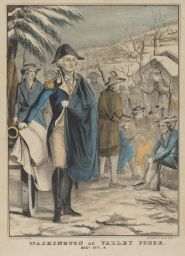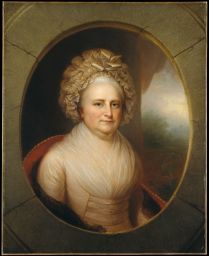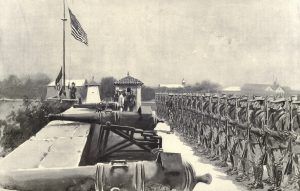It was mid-January 1778 in Mount Vernon, Virginia. Congress had declared independence from Britain roughly a year and a half ago. War had broken out. And leading a rag-tag army of farmers and craftsmen against one of the most powerful armies in the world was General George Washington. But he was not at Mount Vernon in January 1778. He was in Valley Forge, Pennsylvania, with his soldiers. At Mount Vernon was the General’s wife, Martha Washington, who had stayed in order to run the household and farms while her husband was at war. But that January, she received a letter from Valley Forge, from her husband. He missed her, as many of the men who had left their wives, children, and families to fight, did. And she missed him. It had been months since they last saw each other. That is why we can assume that when she read her husband’s request that she join him at the encampment at Valley Forge, she was initially excited. However, there was also, surely, apprehension. Getting from Virginia to Valley Forge was going to be a ten-day-long, cold, dangerous, and uncomfortable journey on unpaved, icy roads. And who knew what condition the men would be in when she arrived? She could hope her husband was well, but the only way to be certain was to go. And above all else, she felt it was her duty to be with her husband when he needed her. He asked her to come. So she did.1
Martha was not travelling to a simple camp. Valley Forge and the soldiers’ trip to it were uncomfortable at best, and deadly at worst. Described by a seventeen-year-old Private in the Continental Army, Joseph Plumb Martin, as a place where “starvation rioted in its glory.” The men were coming off of two battlefield defeats, multiple days without food, no bread or even the flour to make bread, and sleeping on the frozen ground. Lieutenant Colonel Henry Dearborn mused rather grimly, “…I think all we have to be thankful for is that we are alive and not in the grave with most of our friends,” One Brigadier General named Jedediah Huntington wrote, “I hope it is for the best that we are stationed here though I must say I do not see it.” Beyond the physical discomfort, the men were homesick, missing their wives and children, and tensions were rising. French Marshal Victor Francois de Broglie had sent about fourteen officers to the American Congress with orders to persuade them to replace Washington and appoint de Broglie commander in chief of the American army. France did believe in America’s victory, but only if American soldiers took orders from the French. The American soldier’s reaction was hostile, which led Marshal de Broglie to quickly abandon his efforts to become commander in chief, leaving quite a few of his French soldiers displeased. With the combination of starving, freezing, and reports from two Major Generals, two Brigadier Generals, and a Private to General Washington that their men were either without clothing or wearing clothing that was threadbare to the point of disintegration in the freezing temperatures, it was no wonder the camp was overcome with an air of melancholy, particularly their leader, who surely felt responsible for the state of his army.2

There are few first-hand accounts of how the journey to Valley Forge was for Martha Washington, though based on descriptions of the roads that the soldiers travelled and the weather they had endured up to this point, it is likely that she encountered similar troubles on her journey. She was fortunate to arrive when she did, though. The eighth of February brought the heaviest snowfall yet, followed by two or three days of heavy rain. The combination would have caused flooding that would have made the roads impossible to travel on. Beyond the discomfort of the travel, the sights on the road to Valley Forge were shocking to Martha Washington. She had instructed her driver to leave the curtains of her carriage open so she could see just what she was about to experience. The roads were lined with what was described by later writers as “…hollow-eyed, scarecrow-like, ill-clothed soldiers and frozen, half-decayed horse carcasses.”3 Nevertheless, she persisted, despite the horrifying sights, despite personal risk, and despite the personal hardship she experienced. She had just lost her favorite sister, Nancy, in the month before her departure, and nursed Nancy’s sons through smallpox in the months before that.4 There were rumors that the British soldiers were threating her kidnapping. 5 It’s not unreasonable to assume she was scared, emotionally taxed, and physically tired. But she knew her husband and his soldiers needed her.

How much did the General need his wife by his side? French Major General Johann de Kalb made known to the French government that had sent him to America, that he held the General in low regard, calling Washington “disaffected” and “the weakest general he had ever seen.” While it is unclear if General Washington ever heard de Kalb’s comments specifically, many Americans agreed with de Kalb that spending the winter camped in Valley Forge was not a good idea. Couple the doubts being voiced around him with watching his soldiers deteriorate in front of him, and one can only assume that the General, who already had a tendency toward melancholy, needed the emotional support of his wife.6 The melancholia that shrouded the camp left many soldiers feeling lonely and homesick, leading many, including General Washington, to write to their wives, asking that they join the men in Valley Forge. As it turned out, what started as a means to combat his depressed loneliness ended up being one of the most invaluable moves Washington could have made.
Upon her arrival, one of her first concerns was the soldiers whose condition she had seen on her way through the camp to see her husband. As she embraced her husband, relieved to see he seemed as well as he could in the conditions of the war and winter, she said to him, “I’ve never seen men in such terrible living conditions. What can I do?” Martha’s goal had always been to help in any way she could. But the winter conditions were unlike anything she or the soldiers had seen before. Frail, diseased, and injured men were gathering around small fires that barely kept them warm. Bodies were piled into the back of wagons. Her husband told her she could go to the makeshift hospitals of the soldiers. They needed her comfort, her prayers, and her support, as many of them didn’t have their own families in their dying moments. While many soldiers had asked their wives to come, many wives could not, especially with their children. So, Martha went to the hospitals, prayed for the soldiers as she had done throughout the war, and learned from doctors and nurses that what they needed most was food, and that about half the injured or smallpox, diphtheria, or typhus-riddled men could survive if they had enough to properly feed them.7
She returned at noon the next day with six kettles of stew, two for the smaller hospital, four for the larger one. Some soldiers were so grateful, they cried, and when she left for the day, one soldier called the other soldiers, “Lift your cups, lads … to Lady Washington.”8 She would continue to order food from markets and cook meals for the soldiers who needed it. She would bring people together to bring a sense of home and familiarity. It seemed that she truly recognized that one of the things that brought back the spirit of the revolution was being reminded of what they were fighting for. It was the little things in life, like community, family, and real food. This lift in morale and hope for survival, raised by Martha, continued throughout the harsh winter and proved integral to the army’s survival that winter.9

On April 30, 1778, another lift in morale appeared. General Washington received letters from Congress that King Louis XVI of France had just signed two treaties that would guarantee an alliance between France and the United States. This solidified the hope that had been raised by Martha not just for the army’s remaining days at the encampment, but for the rest of the war. While the General did not want to formally announce the news until he had formal confirmation from Congress, he could not help but share the news with his aides, who quickly spread the news among the soldiers, leading to celebration across the camp.10
By May 6, 1778, about a week of celebration had gone by, and it was still going strong. Gone was the melancholia that swept the camp when Martha first arrived, replaced by universal rejoicing. Pints of gin flowed, and prisoners were freed, and Martha happily joined in on the celebrations. Seeing as the skills of being a good hostess were instilled in Martha from a young age, one can assume she headed the celebrations, continuing to raise and solidify hope for American victory, which now seemed far more likely. By June 8, 1778, Martha said goodbye to her husband and headed home to Virginia. Though there were going to be more winters, winters where her husband would need her again, getting through this harsh winter and leaving with hope instilled in herself and her husband’s army, proved that she could help her husband when his army needed her again.11
- Nancy K. Loane, Following the Drum: Women at the Valley Forge Encampment (Lincoln: Potomac Books, 2020), 25-26. ↵
- Thomas J. Fleming, Washington’s Secret War: The Hidden History of Valley Forge (New Word City, Inc, 2015), 10-11. ↵
- Stephen R. Jahrsdoerfer, “First Lady Martha Washington’s Presence a Balm to Valley Forge Troops as Well as Her Husband,” The Journal Gazette (February 8, 2024), https://www.journalgazette.net/opinion/columnists/first-lady-martha-washingtons-presence-a-balm-to-troops-as-well-as-her-husband/article_b709215e-c500-11ee-bf47-f3b6bcd0ced9.html. ↵
- Nancy K. Loane, Following the Drum: Women at the Valley Forge Encampment (Lincoln: Potomac Books, 2020), 25. ↵
- Robert P. Watson, “Remembering Martha: Personality Profile,” OAH Magazine of History 14, no. 2 (2000): 54–56. ↵
- Thomas J. Fleming, Washington’s Secret War: The Hidden History of Valley Forge (New Word City, Inc, 2015), 14. ↵
- Stephen R. Jahrsdoerfer, “First Lady Martha Washington’s Presence a Balm to Valley Forge Troops as Well as Her Husband,” The Journal Gazette (February 8, 2024), https://www.journalgazette.net/opinion/columnists/first-lady-martha-washingtons-presence-a-balm-to-troops-as-well-as-her-husband/article_b709215e-c500-11ee-bf47-f3b6bcd0ced9.html. ↵
- Stephen R. Jahrsdoerfer, “First Lady Martha Washington’s Presence a Balm to Valley Forge Troops as Well as Her Husband,” The Journal Gazette, Fort Wayne, IN, (February 8, 2024), https://www.journalgazette.net/opinion/columnists/first-lady-martha-washingtons-presence-a-balm-to-troops-as-well-as-her-husband/article_b709215e-c500-11ee-bf47-f3b6bcd0ced9.html. ↵
- Nancy K. Loane, Following the Drum: Women at the Valley Forge Encampment (Lincoln: Potomac Books, 2020), 37-38. ↵
- Thomas J. Fleming, Washington’s Secret War: The Hidden History of Valley Forge (New Word City, Inc, 2015), 315-321. ↵
- Nancy K. Loane, Following the Drum: Women at the Valley Forge Encampment (Lincoln: Potomac Books, 2020), 36-37. ↵




2 comments
Patti B.
I really appreciate the timely relevance of this article, as well as the balanced, fair-minded presentation of the often underrated founding figure: Martha Washington. With America’s semiquincentennial approaching, there seems to be a lot of debate about WHO is worth celebrating, and even greater controversary over what can be be said about them. As the pendulum swings between ultra-refined to ultra-revisionist history, it comforts me to see a budding Public Historian shine a light on a new corner of a story we know well. Cate’s article speaks to the significance of female founding figures in our nation’s history. It also highlights the timeless strength that can be found in a balanced, mutually respectful partnership. Well done, Cate!
Ann P. Caplinger
I am so happy to see “Lady Washington” get her just recognition here. Our history books — well, the ones we had 50 or so years ago — just mentioned that she was George’s wife, and that she came from a pampered background. We aee here that she was more tough than pampered, and that she was not afraid of hard work to take care of her husband and his suffering men. Who knows how many might have died without her, or might have just given up? It is so good to see how important Martha Washington was to the survival of our infant nation.